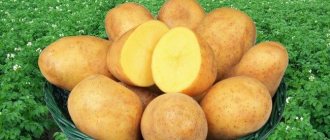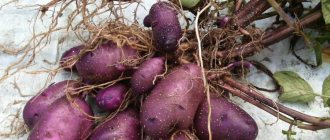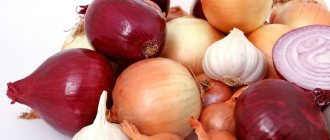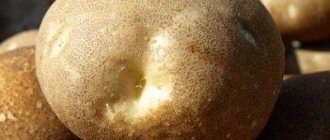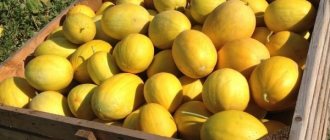Record potato size
The title “The largest potato in the world” since 2008 belongs to a vegetable weighing 11 kg 200 g .
The Farmer Who Raised a Giant
Farmer Khalil Semhat from Saudi Arabia grew the record holder , surpassing European and American vegetable growers. Khalil and his huge potato are listed in the Guinness Book of Records. The size of the vegetable is equal to the girth of three human heads. Variety – yam (sweet potato).
The Arabian surpassed the previous achievement of the Englishman in 1975, growing a vegetable three kilograms heavier. Khalil himself admits that he did not expect to unearth such a huge tuber on his site and was quite surprised when he weighed this “monster.”
The most popular question that the record holder now hears is how he managed to grow such potatoes and what he fertilized them with. However, professionals will be disappointed: Semhat did not use “secret technologies.” Moreover, the farmer admitted that he did not fertilize the vegetable and did not even take special care of it. The potatoes grew on their own, and this is what came out of it. Such huge potatoes can feed an entire village! The size of the harvest is amazing even in the photo.
After becoming a celebrity, Khalil Semhat became even more interested in vegetable growing. Now his harvest is particularly popular with buyers, and the farmer himself continues to actively grow a variety of fruits and vegetables. Perhaps the Arabian hopes to find another record holder in his garden.
How to choose the right potatoes?
Although large potatoes are more pleasant to peel, medium and small tubers contain much more nutrients, so if your goal is to choose a potato variety to store for the winter, don’t go by size. Also pay attention to the thickness of the peel - the thicker it is, the more mature the potato is considered, which means it has a better chance of surviving until spring.
Do not buy potatoes that have turned green or sprouted, as they are full of alkaloids that can cause poisoning. Small holes on the surface of the tubers indicate that the potatoes were “tasted” by a wire beetle, brown spots are a sign of scab - a disease caused by fungal microorganisms, and deep grooves are traces of the larvae of the cockchafer.
If the nail easily cuts the tuber, from which moisture oozes, then the potato was grown using nitrates. High-quality potatoes should be hard and elastic, with a smooth skin without external defects.
The best varieties of potatoes for boiling are those with red and pink skins, as they are not very starchy and hold their shape well. The most delicious variety of potatoes for mashed potatoes is round, with white skin and white flesh, as they are very crumbly, tender and boil instantly. For salads and frying, take less starchy varieties that retain their shape after heat treatment - oblong tubers of yellow and brown color with a yellow core.
Second largest potato
For a long time, the championship title was held by potatoes grown by the Englishman Peter Glazebrook. However, compared to the modern record holder, his competitor had a modest size - 8 kg 730. The Briton presented his vegetable at the National Gardening Exhibition in 2010.
After achieving success and fame, the inspired gardener set out to break his own record. The 66-year-old gardener shares his secrets with others. Unlike Semhat, who let the vegetable grow by itself, Peter believes that it is important to carefully select planting material and observe some of the nuances of cultivation. It takes a lot of effort to get the world's largest potato.
Today, a British farmer can easily be called a professional in growing giant vegetables. His achievements were not limited to potatoes. Over the past 10 years, Peter has grown :
- carrots 5 m long;
- parsnips weighing 16 kg;
- a huge beet 6.5 m.
Third place
Until 2010, the palm was held by another British farmer, K. Sloan. His potatoes weighing 3 kg 500 g were considered the largest and were included in the Guinness Book of Records in 1975.
Interesting things on the site:
The benefits and harms of boiled potatoes
We buy harmless vegetables
Is it possible to eat green potatoes?
The largest varieties of potatoes
More than 270 types of potatoes are registered in the register of vegetable crops . There are also large-sized varieties among them.
Gulliver
Gulliver is one of the youngest potato varieties . It was officially registered and allowed for sale in 2021.
The variety is characterized by high productivity . On one bush, from 5 to 11 potatoes ripen at the same time. It is very popular due to its unpretentiousness (grows at high temperatures and drought) and resistance to various kinds of potato diseases. Gulliver ripens early: the first harvest is dug up 45 days after planting.
The tuber has an oblong shape and weighs from 150 g . From one bush you can get about 2 kg of vegetables. The yield of healthy potatoes is 98%, keeping quality is 95%.
Reviews
It is rare to hear a bad review about Gulliver potatoes . It is called a kind of elite among potato varieties due to its yield, unpretentiousness and taste.
Elizaveta, 32 years old : “Our family cannot live without potatoes, so we really like the early Gulliver variety. At the beginning of June, old potatoes from the cellar do not taste very good, because they have been sitting there all winter. But the new one is swept off the table in a matter of minutes. Unfortunately, the soil on our site is not very good, so we try to fertilize it abundantly, add lime and dolomite flour. Otherwise, the potatoes will grow small and tasteless.”
Nina, 44 years old : “For beginners and inexperienced gardeners, of which I consider myself, the Gulliver variety is the best option. It grows quickly, is easy to care for, and produces a large harvest. Previously, I tried to grow other varieties, but they either got sick or didn’t produce a harvest. I was pleasantly surprised that Gulliver is also suitable for long-term storage. There is such a big harvest that you can’t live without it.”
Description of other large varieties
Other varieties of large potatoes are no less :
- Idaho _ It is distinguished by its large size and regular shape. It is from it that chips, wedges, French fries, etc. are prepared. It has high yield and immunity to many diseases. Nutritious and healthy due to the content of large amounts of starch and carbohydrates.
- Bellarosa (pictured). The variety is grown in Russia, Belarus, Poland and Slovakia. Its distinctive feature is its large size. The tuber can reach 500-600 g, especially with regular watering. The variety is early ripening, so in the southern region they manage to harvest 2 crops per season.
- Gala . Mid-ripening potatoes are yellow in color and large in size - up to 400 g. An average of 5-6 potatoes ripen under one bush. The yield is high, with 85% of the tubers being large. The variety is resistant to diseases.
- Luck . An elite variety that requires careful care, regular watering and a large amount of fertilizer. But he generously rewards the gardener for careful care - the potatoes grow up to 400 g (the record is 4.2 kg). Easily tolerates low and high temperatures. Up to 25 tubers ripen on one bush.
- Rosara . An early ripening variety with a high starch content. The weight of one potato is from 150 g. Under one bush there are up to 20-30 tubers. The variety loves abundant watering and is resistant to fungal diseases.
The best varieties by yield
According to the yield criterion, the best potato varieties are the following:
- Giant. This is a mid-season variety. The weight of one tuber is 140 g. The maximum yield of the Giant potato variety, which can be harvested from 1 hectare, is 600 centners. The tubers have good taste, are well stored, and are resistant to cancer, late blight, and leaf curl.
- Arizona. Potatoes of this type have an average ripening time. The maximum yield is up to 570 centners per hectare. Each tuber weighs 145 g. The variety is characterized by resistance to nematodes and cancer.
- Artemis. This variety belongs to the group of early ripening varieties. It is resistant to most common diseases. If potatoes were planted in the southern regions, it is possible to obtain two harvests in one season. Productivity per hectare is up to 350 centners. Tuber weight – 110-120 g.
- Bryansk novelty. This is a mid-season potato variety that is resistant to many nightshade diseases. The maximum yield is 536 centners per hectare, the average is about 300 centners. The weight of one mature tuber is from 66 to 122 g.
- Bernina. This is the most productive variety. The maximum potato harvest is 704 centners per hectare.
Potato variety "Giant"
Arizona potato variety
Potato variety "Artemis"
Potato variety “Bryansk novelty”
Potato variety "Bernina"
By choosing one of the described potato varieties, you can count on a generous harvest in the fall.
The most productive vegetable varieties for central Russia are discussed in this video:
How to grow large potatoes yourself
If you want to compete for the crown in growing the biggest potatoes, it is recommended to follow these tips :
- Select tubers before planting. Try to use only large, whole, sprouted and strong potatoes as planting material.
- Monitor the temperature. Potatoes do not like heat and do not tolerate cold weather well.
- Arrange potato beds from north to south. This will allow the crop to receive more sunlight.
- Use mineral fertilizers as top dressing: potassium, phosphorus and nitrogen. Professional agronomists also recommend using slurry or an aqueous solution of bird droppings.
- Monitor moisture levels. The need for watering depends on the stage of potato ripening: young and faded potatoes do not need abundant moisture. But during the flowering period, potatoes require watering.
- Do not grow it in soil after peppers, eggplants and tomatoes.
- Adjust the depth of the holes depending on the soil type. The lighter the soil, the deeper you bury the tubers: in loamy soils - 5 cm, on sandstone - up to 15 cm.
- Grow potatoes in one field no more than once every 2-3 years. It is best to plant it in place of grain crops, cabbage, cucumbers or beets.
Why do potatoes turn green?
Potato greening is a natural process.
When potatoes are exposed to light, they begin to produce chlorophyll, a green pigment that gives many plants and algae their color. This causes light-skinned potatoes to change in color from yellow or light brown to green. This process also occurs in dark-skinned potatoes, although dark pigments may mask this—the potato is green under the skin. Potatoes with dark skins can be checked for greening by simply scratching a small portion of the skin.
Chlorophyll also allows plants to harvest energy from the sun through photosynthesis. Through this process, plants can produce carbohydrates and oxygen from sunlight, water and carbon dioxide.
Chlorophyll, which gives potatoes their green color, is completely harmless. In fact, it is present in many plant foods you eat every day. However, greening of potatoes may also signal the production of something less desirable and potentially dangerous—a toxic plant compound called solanine.
Let's summarize:
When potatoes are exposed to light, they produce chlorophyll, the pigment that makes potatoes green. Chlorophyll itself is completely harmless, but it can signal the presence of a toxin.



